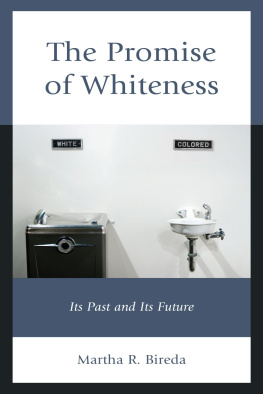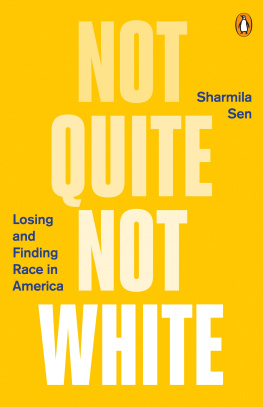
Whiteness on the Border
NATION OF NATIONS: Immigrant History as American History
General Editors: Rachel Buff, Matthew Jacobson, and Werner Sollors
Beyond the Shadow of Camptown: Korean Military Brides in America
Ji-Yeon Yuh
Feeling Italian: The Art of Ethnicity in America
Thomas J. Ferraro
Constructing Black Selves: Caribbean American Narratives and the Second Generation
Lisa D. McGill
Transnational Adoption: A Cultural Economy of Race, Gender, and Kinship
Sara K. Dorow
Immigration and American Popular Culture: An Introduction
Jeffrey Melnick and Rachel Rubin
From Arrival to Incorporation: Migrants to the U.S. in a Global Era
Edited by Elliott R. Barkan, Hasia Diner, and Alan M. Kraut
Migrant Imaginaries: Latino Cultural Politics in the U.S.-Mexico Borderlands
Alicia Schmidt Camacho
The Force of Domesticity: Filipina Migrants and Globalization
Rhacel Salazar Parreas
Immigrant Rights in the Shadows of Citizenship
Edited by Rachel Ida Buff
Rough Writing: Ethnic Authorship in Theodore Roosevelts America
Aviva F. Taubenfeld
The Third Asiatic Invasion: Migration and Empire in Filipino America, 18981946
Rick Baldoz
Race for Citizenship: Black Orientalism and Asian Uplift from Pre-Emancipation to Neoliberal America
Helen Heran Jun
Entitled to Nothing: The Struggle for Immigrant Health Care in the Age of Welfare Reform
Lisa Sun-Hee Park
The Slums of Aspen: Immigrants vs. the Environment in Americas Eden
Lisa Sun-Hee Park and David Naguib Pellow
Arab America: Gender, Cultural Politics, and Activism
Nadine Naber
Social Death: Racialized Rightlessness and the Criminalization of the Unprotected
Lisa Marie Cacho
Love and Empire: Cybermarriage and Citizenship across the Americas
Felicity Amaya Schaeffer
Soft Soil, Black Grapes: The Birth of Italian Winemaking in California
Simone Cinotto
Citizens of Asian America: Democracy and Race during the Cold War
Cindy I-Fen Cheng
Global Families: A History of Asian International Adoption in America
Catherine Ceniza Choy
Whos Your Paddy?: Racial Expectations and the Struggle for Irish American Identity
Jennifer Nugent Duffy
Islam Is a Foreign Country: American Muslims and the Global Crisis of Authority
Zareena Grewal
African and American: West Africans in Post-Civil Rights America
Marilyn Halter and Violet M. Showers Johnson
From the Land of Shadows: War, Revolution, and the Making of the Cambodian Diaspora
Khatharya Um
The Cultural Politics of U.S. Immigration: Gender, Race, and Media
Leah Perry
Strange Fruit of the Black Pacific: Imperialisms Racial Justice and Its Fugitives
Vince Schleitwiler
Whiteness on the Border: Mapping the U.S. Racial Imagination in Brown and White
Lee Bebout
Whiteness on the Border
Mapping the U.S. Racial Imagination in Brown and White
Lee Bebout

NEW YORK UNIVERSITY PRESS
New York
NEW YORK UNIVERSITY PRESS
New York
www.nyupress.org
2016 by New York University
All rights reserved
References to Internet websites (URLs) were accurate at the time of writing.
Neither the author nor New York University Press is responsible for URLs that
may have expired or changed since the manuscript was prepared.
ISBN : 978-1-4798-8534-3 (hardback)
ISBN : 978-1-4798-5853-8 (paperback)
For Library of Congress Cataloging-in-Publication data, please contact the Library of Congress.
New York University Press books are printed on acid-free paper,
and their binding materials are chosen for strength and durability.
We strive to use environmentally responsible suppliers and materials
to the greatest extent possible in publishing our books.
Manufactured in the United States of America
10 9 8 7 6 5 4 3 2 1
Also available as an ebook
For Michael Bebout-Vega
We actively struggle for a more just world
because the other alternatives
are simply not acceptable.
Contents
Social identity labels can be both elucidating and confusing. At the level of academic discourse, scholars often strive for simplicity and clarity. For example, Mexicans, Mexican immigrants, and Mexican Americans may be used to reference three distinct groups of people. However, beyond the pages of academe, the world and words are messier. Mexican may be a label of racial, ethnic, or national identification. And Mexican is not alone. Consider how American may refer not just to a U.S. citizen or someone from the Americas if we are to think hemispherically. Rather, in popular discourse American can be used to reference white U.S. citizens exclusively or non-Latinos more generally. Often this is not purposeful, for the unstated, normalized category of white occupies central positioning in the term American. This is not happenstance or inconsequential. In many ways, this slippage between national and ethnoracial categories is the central thread of this book. In the following pages, I strive for simplicity and clarity, marking the distinction between Mexicans, Mexican Americans, and Anglo-Americans. At points, I deploy Chicana/o, Latina/o, and Mexican American to signal their historical and political differences, but at other times I use Chicana/o transhistorically as has become common in the field of Chicana/o studies. Readers will notice other moments in the text when there is slippage between Mexican and Mexican American as well as between American and Anglo-American. These are not moments of laziness or inadvertent mistakes. They are purposeful acts of signification, for the dynamic tension and play between ethnoracial and national categories is the very heart of the matter.
Perhaps, at some point, all scholarship has its root in the autobiographical. This book certainly feels so. I was born outside of Chicago, Illinois, two hundred years after the United States declared independence, over one hundred years after the end of slavery, approximately thirty years after the defeat of Nazi fascism in Europe, a few years after the end of mass protests that marked the freedom struggles of the 1950s, 1960s, and 1970s, at the cusp of neoliberalism, soft multiculturalism, and color blindness. All this to say, like many others, I was born into white supremacy in a time like today when many whites sought a clean break from the past, a chance to baptize themselves in dreams of innocence.
Raised by my mother, I was taught that racism is wrong. This is a value that is imparted by many white parents today. Knowing this is not enough. Knowing that racism is wrong does not account for what racism is or what it does. Knowing that racism is wrong does not arm oneself with strategies for combating injustice. These two gaps create significant challenges today as racism is popularly conflated with outward expressions of personal prejudice and the solution is simply to dont say things like that. Like many white families, mine rarely spoke of race and racial difference, and when it did, race was coded below the surface of politeness.
Growing up in the western suburbs of Chicago in the 1980s, my conscious introduction to the U.S. racial imagination was largely through television and racial comments by friends and adults outside my family. The targets of jokes would be Polish Americans or black people
Next page







